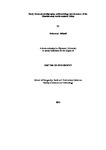Early Mesozoic stratigraphy, sedimentology and structure of the
| dc.contributor.supervisor | Stokes, Martin | |
| dc.contributor.author | Alfandi, Emhemed | |
| dc.contributor.other | School of Geography, Earth and Environment Sciences | en_US |
| dc.date.accessioned | 2012-03-09T11:40:54Z | |
| dc.date.available | 2012-03-09T11:40:54Z | |
| dc.date.issued | 2012 | |
| dc.date.issued | 2012 | |
| dc.identifier | 10110465 | en_US |
| dc.identifier.uri | http://hdl.handle.net/10026.1/917 | |
| dc.description.abstract |
The Gharian area is used as a case study to examine the sedimentary succession, structural evolution and timing of sedimentary and structural events during basin development in the Early Mesozoic. These sediments (Kurrush, Al Aziza and Abu Shaybah Formations) are examined in order to provide palaeonvironmental and palaeogeographic reconstructions for the study area. The formations are described using facies analysis. The Kurrush is probably deposited in delta plain environment. A complete section (140 m) has been logged and seven facies from the Al Aziza Formation represent a shallow shelf platform area (inner ramp: an intertidal-subtidal carbonate flat to shelf lagoonal environment), which was deposited during the opening of the Early Triassic Neo-Tethys Ocean. Eleven localities from the Abu Shaybah Formation have been investigated with a cumulative thickness of 125 m. Ten facies from the Abu Shaybah Formation represent deposition in a shallow marine environment as part of low gradient continental margin, succeeded by sand deposition in braided and meandering fluvial systems. Regional tectonic activity, regional relative sea-level fluctuations and climatic conditions led to control of the sedimentary megasequences (266 m coarsening upward and fining upward megasequence). A magnetostratigraphic analysis was undertaken in the above units as their depositional age is poorly constrained and currently based on limited fossil evidence. Most of these samples convey a weak but stable remanent magnetization. The Al Aziza Formation yielded a primary remanence that has suffered a substantial post-acquisition clockwise rotation (~50˚). Restoration of the rotation about a simple vertical axis would place the pole on the APW path at an appropriate point in time. The palaeomagnetic data from the studied formations yield a distinct series of polarity zones that provide clear local and regional correlation and are readily tied to a recently compiled global magnetostratigraphic time scale. The Al Aziza Formation at Gharian is latest Ladinian in age, whilst the Abu Shaybah Formation is earliest Carnian in age. The Abu Shaybah Formation at Gharian suggests that the stratigraphic equivalence with the Aziza Formation at Azizyah and Kaf Bates (Jafarah Plain). The study established that the Gharian area is the expression of major normal faults (NNE-SSW, WNW to ESE, NW to NNW and NE-SE) in a system of half-grabens which formed as part of the African extensional margin on the southern Tethyan margin in Latest Early Cretaceous. | en_US |
| dc.description.sponsorship | Libyan Government | en_US |
| dc.language.iso | en | en_US |
| dc.publisher | University of Plymouth | en_US |
| dc.subject | Structure | |
| dc.subject | Gharian | |
| dc.subject | Libya | |
| dc.subject | Sedimentology | en_US |
| dc.title | Early Mesozoic stratigraphy, sedimentology and structure of the | en_US |
| dc.type | Thesis | |
| dc.identifier.doi | http://dx.doi.org/10.24382/3376 |
Files in this item
This item appears in the following Collection(s)
-
01 Research Theses Main Collection
Research Theses Main


